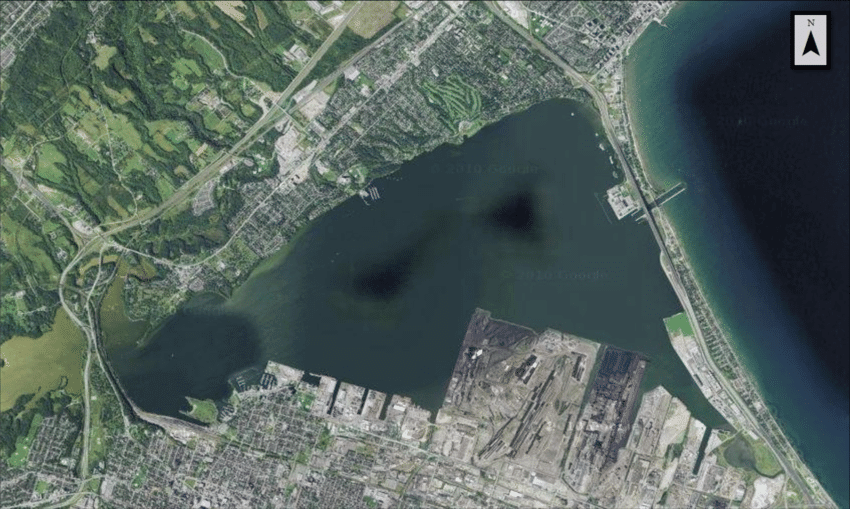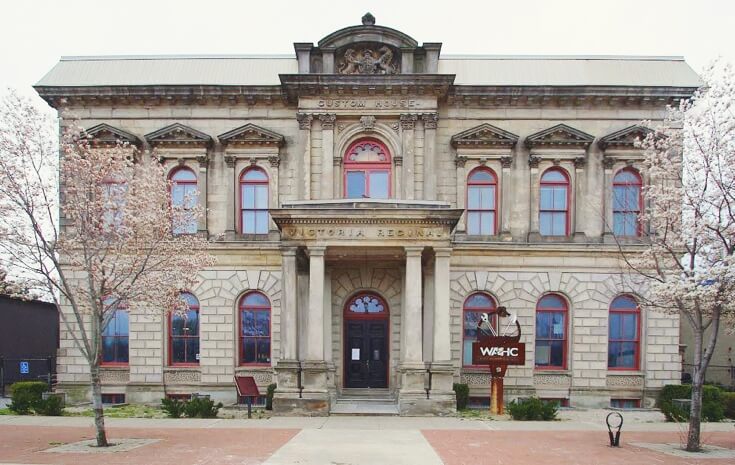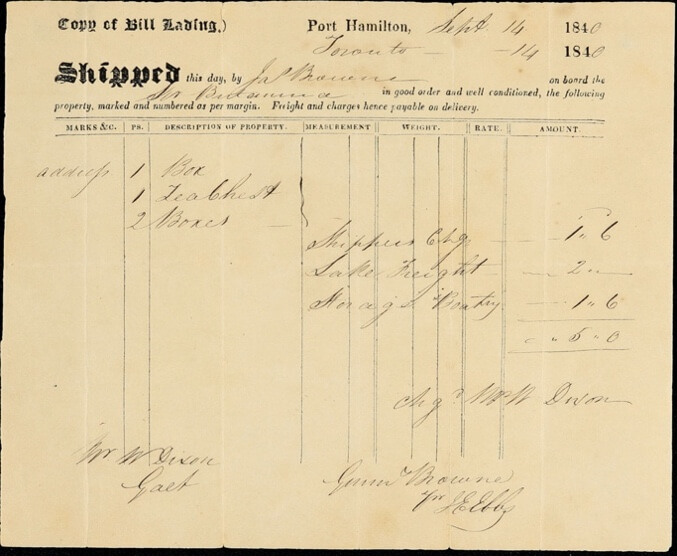Examining The Role of the Custom House in Hamilton
Jaimee van Staalduinen
Hamilton - 2022
Introduction
The Port of Hamilton has seen several changes in a relatively short amount of time while experiencing mass city growth, development, and the rise of shipping on the Great Lakes. Many factors have affected the city of Hamilton over the years, making the Port of Hamilton one of the busiest ports on the Great Lakes. These developments include the creation of new canals and waterways, such as the Burlington Bay Canal (1832), and the creation of the Great Western Railway (1854). These developments impacted the shipping industry and highlight why the port has been so significant to the city’s history. This essay will explore the history of the Port of Hamilton, specifically discussing the Custom House and its integral role in the port’s history by regulating imports and exports that contributed to the flourishment of Hamilton. The Custom House was ultimately an overseer of port activity and has been an important factor in the economic development of the port city. The rise of shipping on the Great Lakes brought new opportunities with the increase of movements of people and goods. With this development, ports needed to create more precise guidelines for shipping and a develop a record keeping system which was done through the Custom House.
Background
It is important to understand what ports are and the significant role they played within the shipping industry. A port is an established landing point for the loading and unloading of sea cargo.1 The purpose of building ports was to create a central location for people and goods to converge so they could be shipped across the country and

Figure 1: Aerial view of Hamilton Harbour, 2010
internationally. Ports were often positioned close to the town centre where they became a hub for jobs, a key location to establish business in the area, or as a place of networking. Shipowners were able to rapidly send out ships while being cost efficient following the development of ports.2 Any port could have a large impact on the surrounding community, particularly through the economic and demographic growth that often develop around ports, such as new buildings and the migration of people who are looking for new places to work and live.
The geographical location of Hamilton Harbour is on the West side of Lake Ontario with the city of Hamilton and city of Burlington surrounding it (Figure 1).3 It has a prime location for economic and urban growth being between these two cities and near the railway. Before becoming a busy Canadian port, access to the bay was originally very shallow, allowing only small and light boats such as canoes or draft boats to enter. The government was eager to develop the harbour as they saw its economic potential, but first needed to improve the waterways. In 1823, an act was passed for construction of a deeper channel to connect with Lake Ontario that would allow much bigger boats to enter the harbour. This channel would become known as Burlington Bay. Construction began in 1823 and was in completed in 1826, but after evaluation it was decided that it needed to be deeper to cater to larger vessels.4 The ongoing project and its completion in 1832 brought a lot of people to the harbour where they built a community close to the water. New infrastructure such as large docks, cranes, and storage needed to be implemented for the large cargo loads and different vessels that would come. Common vessels that were on the lake visiting the port from 1755-1875 included ships such as sloops, schooners, brigantines, barques, and gunboats along with others.5
Another factor that influenced the importance of the port was the implementation of the Great Western Railway. Construction started in 1851 with the idea that the railway would be economically prosperous for national purposes and colonial interests. There were three main lines being constructed and two of them were based in Hamilton and then later spread out, highlighting Hamilton’s key location.6 Over the next few years, the city would be working on the railroad until its completion in 1854. Labourers were needed for railroad construction, and many moved to Hamilton for work which increased the city’s population. The development of the railway enabled shipping to be more widespread as goods and resources could be brought by trains and then transported on ships. With access to the port and the railway, Hamilton served as a key location for the transportation of goods, and it was decided that there should be a proper customs system that would record the shipments going through the port.
The Custom House
Up until the 1840s, most of the people within Hamilton were of Anglo-Saxon decent or British immigrants. There was also an influx of Irish immigrants, making the population close to 7000 people in 1846.7 In the following years, the population of Hamilton would continue to grow, with the railway and ships allowing the city to become more accessible. Hamilton was also attractive to travellers and tourists.
With the continual growth of the city during this period, and only a year after the completion of the railway, the United Province of Canada Legislative Assembly commissioned the city to build a Custom House which opened in 1860 (see Figure 2).8

Figure 2: The Hamilton Custom House
The task of the custom house was to collect the taxes and tariffs from goods coming into the Port of Hamilton. Hamilton’s first customs department started with only one man, named George Chisholm, in 1832. Chisholm had to rely on merchants being honest with their record of goods and paying the proper duties each month. Many merchants found this system easy to get around and manipulate. For example, Customs Officer, John Henry Palmer, had a problem with smugglers in 1844 when he received a tip that a ship was smuggling cargo in the night to avoid paying the proper taxes.9 Taxes were generally applied on the imports and exports of goods based on factors such as their weight, value, etc. whereas tariffs were specific to certain items. An increase in population and a rise in shipping demanded that the city develop a more structured system to record the movement of goods because the system could no longer rely on the honesty of the shipmen to pay taxes accordingly.
The Custom House started off with 15 employees whose jobs included the collector, surveyor, landing waiter, appraiser, searcher/packer, sub-collector, and broker.10 The workers received regular wages and had the daily task of dealing with several different types of people including sailors, longshoremen, railway men, and teamsters.11Employees not only collected money from ships but were also required to check if each ship had the proper paperwork and documents onboard such as the Bill Landing (see Figure 3).12 Upon arrival at the port, goods needed to be claimed on a Bill Landing and have charges payable on delivery. These slips contained information on the cargo such as what it was, where it was from, its weight and dimensions, along with the name of the ship that it was brought on.13 Something that the port and custom officers struggled with throughout the years was the fairness and equality of the taxes across the board. In 1880, there were accusations against the appraiser that they were overtaxing some goods for the benefit of the manufacturers and dealers, and that the Commissioner of Customs should investigate the matter.14 Without a proper system and law on shipping in colonial Canada, the ability to bend the taxes or costs could occur.

Figure 3: A Bill of Landing for Tea chests and boxes, 1840
The physical building is one of the oldest remaining ‘federal’ buildings in Canada, still standing at 51 Stuart Street in Hamilton.15 The Custom House reflects the city’s role as a Great Lake port and station of the Great Western Railway.16 The building was designed by Frederick J. Rastrick and F.P. Rubridge and is a good example of the early Victorian and Italianate architectural style that was popular in Upper Canada from the 1830s until the end of the nineteenth century. It contains grand architectural features that are loosely from the Renaissance such as the grand arch, a columned entryway, and intricate detailing. The historical building itself is two storeys in height, measuring 60 feet front by 50 feet depth. The original cost of the building was $40,000.17 The building also contains living quarters for the caretakers and a vault that was used to store some goods such as temporarily seized cargo.
The Customs department moved out of the original building in 1887 and since then, the building has been home to a variety of services. The building was temporarily a school, a residence, a factory, a martial arts academy, and a computer company until the Workers Art and Heritage Centre bought the building in 1995 and restored it to what is it now.18 The use of a Custom House is not necessary anymore as taxes and tariffs responsibilities now fall on the federal government. There are more guidelines on shipping, but it has continued to become a vital part of Canada’s accessibility to goods through worldwide shipping. The Custom House is a rich part of the Port of Hamilton’s history by its ability to control the import and export of goods and contributing to the economic development of the country.
Conclusion
The growth of the city of Hamilton can be credited to the major role that the Port of Hamilton played with its ideal location and access to other waterways that was essential to shipping. As a shipping base, the Port of Hamilton allowed bulk goods and resources to travel new distances and to new places. The port continued to make changes to support larger ships and the amount of goods coming into the port such as deepening the canal and building new infrastructure. The transportation of goods within Hamilton became even stronger with the construction of the Great Western Railway that had a station and two major lines within Hamilton. With new developments and economic potential, Hamilton was becoming an attractive city for people to make home, for the transportation of goods, and for the growth of businesses.
With the rising population and trade of goods, the Port of Hamilton required a system that could properly tax the goods passing through. The newly built Custom House served an imperative role in the expansion of the city of Hamilton by inspecting the shipments, examining paperwork, and taxing shipments. The building itself continues to serve as a reminder of how the Port of Hamilton was able to expand and play a key role in Hamilton’s booming economy. The port is still of national importance, handling an estimate of 2 billion worth of cargo every year.19 Although Custom Houses are not necessarily needed anymore, the system of taxes and tariffs that were developed remains today. The city of Hamilton would not be the same as it is today without the Port of Hamilton and the impact that the Custom House had on shipping regulations and organization.
-
Sarah Palmer, “History of the Ports,” International Journal of Maritime History 32, no.2, (2020). ↩
-
Adrian Jarvis, “Port History: Some Thoughts on Where it Came from and Where it Might be Going,” International Maritime Economic History Association: St. John’s, Newfoundland (1999). ↩
-
Figure 1: Susan E. Doka, “Aerial view of Hamilton Harbour,” Image, ResearchGate, accessed March 2022, https://www.researchgate.net/figure/Aerial-view-of-Hamilton-Harbour-4314N-7951W-located-at-the-western-end-of-Lake_fig2_342663798. ↩
-
Bill Freeman, Hamilton: A People’s History (J. Lorimer, 2001), 30. ↩
-
“List of Vessels Employed on British Naval Service on the Great Lakes, 1755-1875,” Maritime History of the Great Lakes, accessed March 2022, https://www.maritimehistoryofthegreatlakes.ca/documents/Macpherson/default.asp?ID=c1. ↩
-
Great Western Railway Company, The Great Western Railway of Canada (London: T. Brettell,1851), 7, https://www.canadiana.ca/view/oocihm.63691/7. ↩
-
Freeman, Hamilton. ↩
-
Figure 2: “The Custom House,” Workers Arts and Heritage Centre, accessed March 2022, https://wahc-museum.ca/custom-house/. ↩
-
Ivan S. Brookes, “Chapter 6- 1844-1847, 1844,” in Hamilton Harbour 1826-1901 (The Estate of Ivan S. Brookes), https://www.maritimehistoryofthegreatlakes.ca/documents/Brookes/default.asp?ID=Y1844. ↩
-
James Sutherland (compiler), Sutherland’s City of Hamilton and County of Wentworth Directory for 1868-9 (Hamilton, ON: A. Lawson & Co, 1869), https://archive.org/details/186869SutherlandsHamiltonCityDirectory/page/n73/mode/2up. ↩
-
““The Custom House.” ↩
-
Figure 3: A Bill of Landing (copy) for Tea chests and boxes received at Port Hamilton, 1840,
https://ocul-bu.primo.exlibrisgroup.com/permalink/01OCUL_BU/3kjbnu/alma991009255218505152. ↩
-
A Bill of Landing. ↩
-
Our, Own Correspondent, "Hamilton News: Favouritism at Hamilton Custom House.” The Globe, Sept. 16, 1880. ↩
-
“The Custom House.” ↩
-
City of Hamilton, “Hamilton’s Heritage Volume 5,” (June 2005): 142, https://www.hamilton.ca/sites/default/files/media/browser/2014-12-16/hamiltons-heritage-volume-5.pdf. ↩
-
Sutherland, Directory, 56. ↩
-
“The Custom House.” ↩
-
CanadianSailings, “The Port of Hamilton: A Proud History,” August 14, 2012, https://canadiansailings.ca/the-port-of-hamilton-a-proud-history/. ↩

